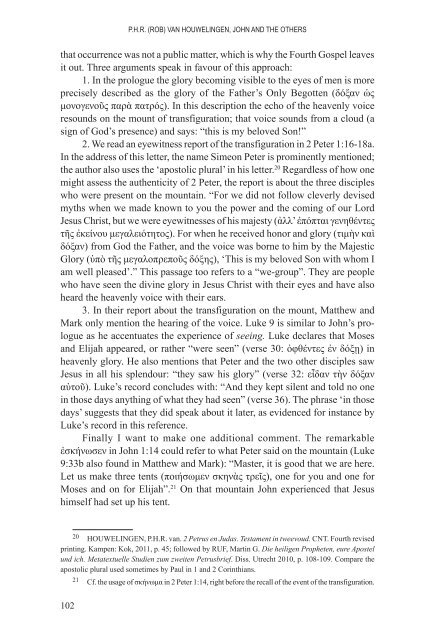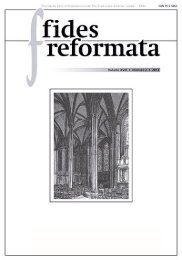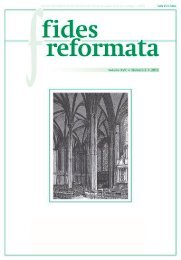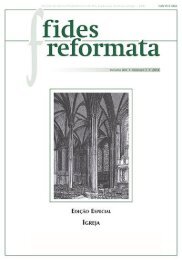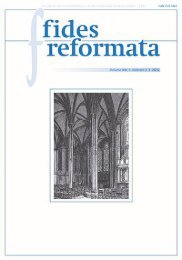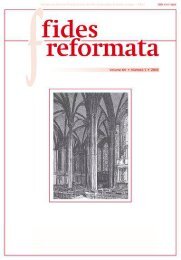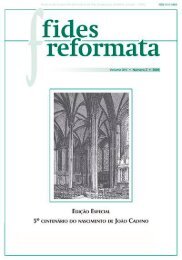Create successful ePaper yourself
Turn your PDF publications into a flip-book with our unique Google optimized e-Paper software.
P.H.R. (Rob) van Houwelingen, John and the Others<br />
that occurrence was not a public matter, which is why the Fourth Gospel leaves<br />
it out. Three arguments speak in favour of this approach:<br />
1. In the prologue the glory becoming visible to the eyes of men is more<br />
precisely described as the glory of the Father’s Only Begotten (δόξαν ὡς<br />
μονογενοῦς παρὰ πατρός). In this description the echo of the heavenly voice<br />
resounds on the mount of transfiguration; that voice sounds from a cloud (a<br />
sign of God’s presence) and says: “this is my beloved Son!”<br />
2. We read an eyewitness report of the transfiguration in 2 Peter 1:16-18a.<br />
In the address of this letter, the name Simeon Peter is prominently mentioned;<br />
the author also uses the ‘apostolic plural’ in his letter. 20 Regardless of how one<br />
might assess the authenticity of 2 Peter, the report is about the three disciples<br />
who were present on the mountain. “For we did not follow cleverly devised<br />
myths when we made known to you the power and the coming of our Lord<br />
Jesus Christ, but we were eyewitnesses of his majesty (ἀλλ’ ἐπόπται γενηθέντες<br />
τῆς ἐκείνου μεγαλειότητος). For when he received honor and glory (τιμὴν καὶ<br />
δόξαν) from God the Father, and the voice was borne to him by the Majestic<br />
Glory (ὑπὸ τῆς μεγαλοπρεποῦς δόξης), ‘This is my beloved Son with whom I<br />
am well pleased’.” This passage too refers to a “we-group”. They are people<br />
who have seen the divine glory in Jesus Christ with their eyes and have also<br />
heard the heavenly voice with their ears.<br />
3. In their report about the transfiguration on the mount, Matthew and<br />
Mark only mention the hearing of the voice. Luke 9 is similar to John’s prologue<br />
as he accentuates the experience of seeing. Luke declares that Moses<br />
and Elijah appeared, or rather “were seen” (verse 30: ὀφθέντες ἐν δόξῃ) in<br />
heavenly glory. He also mentions that Peter and the two other disciples saw<br />
Jesus in all his splen<strong>do</strong>ur: “they saw his glory” (verse 32: εἶδαν τὴν δόξαν<br />
αὐτοῦ). Luke’s record concludes with: “And they kept silent and told no one<br />
in those days anything of what they had seen” (verse 36). The phrase ‘in those<br />
days’ suggests that they did speak about it later, as evidenced for instance by<br />
Luke’s record in this reference.<br />
Finally I want to make one additional comment. The remarkable<br />
ἐσκήνωσεν in John 1:14 could refer to what Peter said on the mountain (Luke<br />
9:33b also found in Matthew and Mark): “Master, it is good that we are here.<br />
Let us make three tents (ποιήσωμεν σκηνὰς τρεῖς), one for you and one for<br />
Moses and on for Elijah”. 21 On that mountain John experienced that Jesus<br />
himself had set up his tent.<br />
20 HOUWELINGEN, P.H.R. van. 2 Petrus en Judas. Testament in tweevoud. CNT. Fourth revised<br />
printing. Kampen: Kok, 2011, p. 45; followed by RUF, Martin G. Die heiligen Propheten, eure Apostel<br />
und ich. Metatextuelle Studien zum zweiten Petrusbrief. Diss. Utrecht 2010, p. 108-109. Compare the<br />
apostolic plural used sometimes by Paul in 1 and 2 Corinthians.<br />
21 Cf. the usage of σκήνωμα in 2 Peter 1:14, right before the recall of the event of the transfiguration.<br />
102


